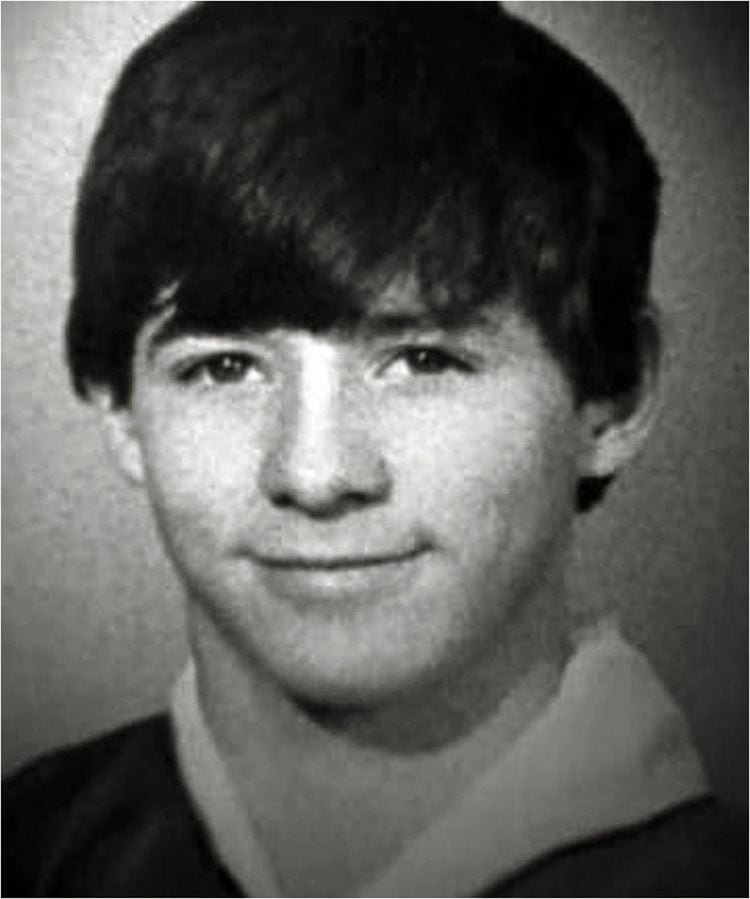Criminal penalty Death | Victims 3 Name John Joubert | |
 | ||
Full Name John Joseph Joubert IV Born July 2, 1963 ( 1963-07-02 ) Lawrence, Massachusetts, U.S. Other names The Nebraska Boy SnatcherThe Woodford Slasher Span of killings August 22, 1982–December 2, 1983 Died July 17, 1996(1996-07-17) (aged 33) Lincoln, Nebraska, U.S. Similar Gary Ray Bowles, Alton Coleman, Westley Allan Dodd | ||
Boy Scout Turned Serial Killer: The John Joubert Story I Dispatches From The Middle
John Joseph Joubert IV (July 2, 1963 – July 17, 1996) was an American serial killer convicted of the murders of three boys in Maine and Nebraska. He was executed in Nebraska.
Contents
- Boy Scout Turned Serial Killer The John Joubert Story I Dispatches From The Middle
- Childhood
- Murders
- Arrest
- Trials and appeals
- References

Childhood

Joubert was born in Lawrence, Massachusetts, on July 2, 1963. A bright child, he began reading at age 3 and borrowing books from a public library at 5. He was later found to have an IQ of 123, signifying above average intelligence. Joubert's parents divorced when he was 6 years old, and he stayed to live with his mother, whom he greatly resented throughout his life as being excessively controlling. His mother forbade him to see his father, and often stood in the way of his developing connections with his peers and spanked him up until he was 12 years old. He also had problems with his peers, who taunted him on the basis of his relatively small build from the time he was in grade school up until high school.

From a very young age, Joubert began having increasingly violent sadistic fantasies. According to three psychiatric reports prepared on Joubert in 1984, his earliest sadistic fantasies began at around the age of 6. These fantasies revolved around murdering and cannibalizing a neighborhood girl who babysat him. To one psychiatrist, he described having nothing personal against the girl, seeing her as "just someone to kill."
In 1971, Joubert's mother moved them out of their former house into a rundown apartment. At this time, he was considered an outcast at school, and sought to compensate for these feelings of isolation by joining cub-scouts. It was around this time that his sadistic and homicidal fantasies progressed to the point where he contemplated murdering strangers on the streets, tying and gagging those who resisted him. In one later psychiatric report, he was described as saying that he derived pleasure from the thought of his victims saying "if you are going to do it, get it over with."
In 1974, Joubert's mother moved his family to Portland, Maine, and got a job as a bookkeeper. Here, his family settled in a two-story home in the middle-class Oakdale neighborhood. While he attended school in Portland, his problems with his peers began to intensify. He confessed at the age of 12 to having homosexual tendencies, and was further teased and ostracized because of it.
When he was 13, he stabbed a young girl with a pencil and felt sexually stimulated when she cried in pain. The next day, he took a razor blade and slashed another girl as he biked past her. In another incident, he beat and nearly strangled another boy. He relished the power of bullying, and continued to brutally attack his peers and younger children. At around age 16, he throttled an 8-year-old boy named Chris Day, almost killing him. Each offense occurred with gradually higher intensity, and each time Joubert successfully evaded getting caught.
Murders
In the city of Portland, Maine, on August 22, 1982, 11-year-old Richard "Ricky" Stetson had gone jogging on the 3.5 mile long Back Cove trail. When he had not returned by dark, his parents called the police. The next day, a motorist saw the boy's body on the side of US I-295. The attacker appeared to have attempted to undress him, and then stabbed and strangled him. A suspect was arrested for the murder, but his teeth did not match a bite mark on Stetson's body, so he was released after a year and a half in custody. No additional leads presented themselves in the case until January 1984.
Danny Joe Eberle disappeared while delivering the Omaha World-Herald newspaper on Sunday, September 18, 1983, in Bellevue, Nebraska. His brother, who also delivered the newspaper, had not seen him, but he did remember being followed by a white man in a tan car on previous days. It was found that Eberle had delivered only three of the 70 newspapers on his route. At his fourth delivery, his bicycle was discovered along with the rest of the newspapers. There appeared to be no sign of a struggle. Joubert would later describe how he had approached Eberle, drawn a knife, and covered the boy's mouth with his hand. He instructed Eberle to follow him to his truck and drove him to a gravel road outside the town.
After a three-day search, Eberle's body was discovered in a patch of high grass alongside a gravel road some 4 miles (6 km) from his bicycle. He had been stripped to his underwear, his feet and hands had been bound, and his mouth had been taped with surgical tape. Knife wounds across his body suggested he had been tortured before death. In addition, Joubert had stabbed him nine times. As a kidnapping, the crime came under the jurisdiction of the federal government of the United States, so the FBI was called in.
The investigation followed several leads, including a young man who was arrested for molesting two young boys about a week after the crime. He failed a polygraph test and had a false alibi but did not fit the profile the FBI had created for the murderer. He was released due to a lack of evidence. Other known pedophiles in the area were also questioned, but the case went cold due to a scarcity of evidence.
On December 2, Christopher Walden disappeared in Papillion, Nebraska, about 3 miles (5 km) from where Eberle's body had been found. Witnesses again said they saw a white man in a tan car. Joubert said that he had driven up to Walden as he walked, showed him the sheath of his knife and ordered him into the car. After driving to some railways lines out of town, he ordered Walden to strip to his underwear which he did. But then Walden refused to lie down. After a brief struggle, Joubert overpowered and then stabbed him. Joubert cut Walden's throat so deeply that he was almost decapitated. Walden's body was found two days later 5 miles (8 km) from the town. Although the crimes were similar, there were differences. Walden had not been bound, had been concealed better, and was thought to have been killed immediately after being abducted.
Arrest
On January 11, 1984, a preschool teacher in the area of the murders called police to say that she had seen a young man driving in the area. There are conflicting stories as to what occurred - whether the car was loitering or just driving around. When the driver saw the teacher writing down his license plate, he stopped and threatened her before fleeing. The car was not tan, but was traced and found to be rented by John Joubert, an enlisted radar technician from Offutt Air Force Base. It turned out that his own car, a tan Nova sedan, was being repaired.
A search warrant was issued, and rope consistent with that used to bind Danny Joe Eberle was found in his dorm room. The FBI found that the unusual rope had been made for the United States military in South Korea. Under interrogation, Joubert admitted getting it from the scoutmaster in the troop in which he was an assistant.
Robert K. Ressler, the FBI's head profiler at the time, had immediate access to the information about the two boys in Nebraska and worked up a hypothetical description which matched Joubert in every regard. While he was presenting the case of the two Nebraska boys to a training class at the FBI academy at Quantico, a police officer from Portland, Maine, noted the similarities to a case in his jurisdiction which took place while Joubert lived there prior to joining the Air Force. Bite-mark comparisons proved that Joubert was responsible for the Maine killing in addition to those in Nebraska. Ressler and the Maine investigators came to believe that Joubert joined the military to get away from Maine after the murder of the Stetson boy.
Further investigation in Maine revealed two crimes between the pencil-stabbing of the 9-year-old girl in 1979 and the murder of Stetson in 1982. In 1980, Ressler's investigation revealed that Joubert had slashed a 9-year-old boy and a male teacher in his mid-20s who both "had been cut rather badly, and were lucky to be alive."
Trials and appeals
Joubert then confessed to killing the two boys, and on January 12, 1984, he was charged with their murders. After initially pleading not guilty, he changed his plea to guilty. There were several psychiatric evaluations performed on Joubert. One characterised him as having obsessive-compulsive disorder and sadistic tendencies, and suffering from schizoid personality disorder. He was found to have been not psychotic at the time of the crimes. A panel of three judges sentenced him to death for both counts. Joubert was also sentenced to life imprisonment in Maine (which did not have the death penalty) in 1990 for the murder of Ricky Stetson after Joubert's teeth were found to match the bite mark.
In 1995, Joubert filed a writ of habeas corpus to the United States federal courts over the death sentences. His lawyers argued that the aggravating factor of "exceptional depravity" was unconstitutionally vague, and the court agreed. The state of Nebraska appealed to the United States District Court for the District of Nebraska, which overturned the appeal, saying that he had shown sadistic behavior by torturing Eberle and Walden.
Joubert was executed on July 17, 1996, by the state of Nebraska in the Electric chair.
An appeal to the Nebraska Supreme Court over whether the electric chair in Nebraska is a cruel and unusual punishment revealed that during his execution, Joubert suffered a four-inch brain blister on the top of his head and blistering on both sides of his head above his ears.
